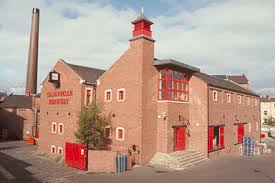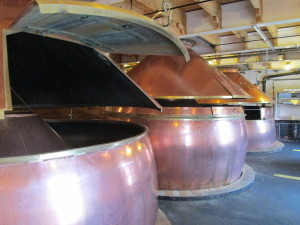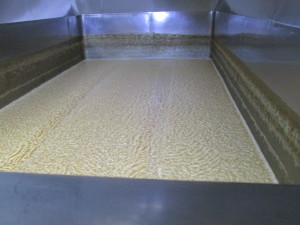Unlike England, which has more breweries than you can keep track of, Scotland has a relatively small brewery network. There is, of course, Tennent’s, until recently an AB-Inbev brand but now owned by cider distributor C&C Group, which dominates the Scottish landscape much like Canadian. There are a few dozen smaller breweries, mostly created in the past couple of decades as part of the craft beer revolution.
In late 1800s Edinburgh there were 40 breweries. Today, only one of those breweries remains. Caledonian Brewing was created in 1869 by George Lorimer and Robert Clark. Success came quickly to not just Caledonian, but other regional brewers. Caledonian grew fast and even had their own train line to facilitate shipments to England
Caledonian was known for its traditional Scottish ales – dark, malt accented beer with a clean body. They were not unique in this fashion, as the clean Edinburgh water and prohibitive taxes on hops, which must be imported from England, fed Scottish brewing approaches.
But as the pale lager revolution swept the globe, most of Caledonian’s compatriots fell by the wayside. Caledonian itself went through many ups and downs and was eventually bought out by growing international Scottish and Newcastle in 2004. the swallowing of S&N in 2008 led to Caledonian being handed over to to Heineken.
While I was in Edinburgh I decided to arrange a visit to the brewery. After all when will I next get to tour a 144 year-old brewery? Plus I was curious how they have fared over the years of corporate ownership. Interestingly (and somewhat oddly) they wanted me to come on a Sunday, where the only people in the brewery were the guide, a security guard and me. It is an odd feeling walking around an empty brewery. However it meant I got a highly tailored visit.
Caledonian is a medium-sized regional brewery along the lines of Big Rock or Mill Street. However, 70% of their production ends up as cask ale to be sold within days around the UK.
The brewery is a blend of old and new. Much of the new, which includes state of the art grain mills and bright tanks, is due to a fire a few years ago that destroyed part of the brewery. However, the core of the brewery remains unchanged since 1869. The copper kettles are original, and of a design I have never seen before (see photo). They perform traditional British open fermentation in Burton Squares, and they top crop the yeast during fermentation. I have never seen this method before – most North American breweries are steadfastly attached to their closed conical fermenters. It was a fascinating sight and reminded me of homebrewing in their instinctive trust in yeast to ward off any baddies.
That and the old brick building remind you constantly of the brewery’s origins, which might explain why they have resisted adopting more modern methods (not to give an impression of stubbornness they, of course, have adapted in key ways, taking on modern scientific approaches to lab testing and sanitation, for example). It also possibly explains why Heineken has been resolutely hands-off with the beer. Nothing has changed, I am told, in recipe design, ingredients and process. I can confirm the ingredients hold fast, as all their grain and hop varieties (exclusively whole hop) are labeled in full view in the brewery – and they were of types expected for British ale.
They also have not succumbed to the North American corporate tradition of round-the-clock brewing. They only brew Monday thru Wednesday and do packaging, clean up and maintenance Thursday and Friday, taking the weekend off. In part, I suspect, this is because so much of their production is cask-related, which likely alters the natural brewing cycle. I know, for example that they have 16 fermentation squares, but only two bright (secondary) tanks.
They have four regular beer available both in the bottle and in cask – Deuchar’s IPA, Flying Scotsman, Caledonian 80/ and Golden XPA. They also produce a monthly rotational. All fit the classic British tradition of fruity, balanced ales. I found the 80/ to be a nice example of a Scottish Export. For hop heads the Deuchar’s will be timid, but it has a drinkability to it that North American versions can lack.
Caledonian is not currently available on the prairies, but it can be found in some parts of Canada, I am told.
All in all it was a wonderful opportunity to glance at a brewing tradition we Johnny-Come-Latelies across the pond have little direct link to.





July 22, 2013 at 10:21 AM
Brew kettles are of the percolator style. Also know as an internal calandria. Originally direct coal fired, many converted to direct firing by oil or natural gas. Direct firing is tricky due to wort burn on and colour variability. Probably steam heated now. Did they mention anything about external heating?
July 22, 2013 at 1:46 PM
Oh, and the fermenters are “Yorkshire Squares”. I’ve never heard of these being used anywhere outside of a handful of British brewers.
July 22, 2013 at 5:55 PM
They said they are steam heated, but didn’t tell me what the original heat source was.